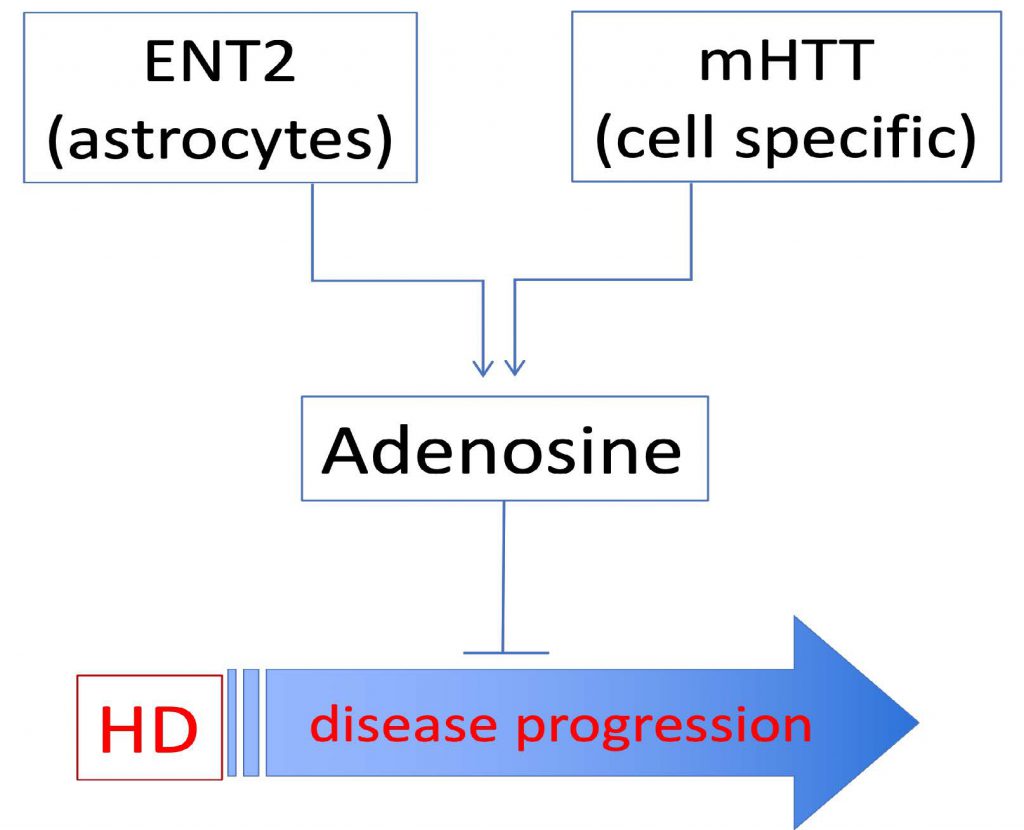探討神經元與星狀細胞在調控亨丁頓舞蹈症腦內腺嘌呤核苷酸所扮演之角色
The roles of neurons and astrocytes in the modulation of adenosine and adenine nucleotides in the brain of Huntington’s disease
Huntington’s disease (HD) is a dominant autosomal neurodegenerative disease whose treatment is an unmet need. While mutant huntingtin (mHTT) is known to play a critical role in the pathogenesis of HD, the underlying mechanisms for HD pathogenesis are still far from clear, which limits the development of HD therapy. Our previous studies have suggested that adenosine homeostasis is important for the pathogenesis of HD. This study was supported to investigate the regulation of adenosine and adenine nucleotide homeostasis in differnt cell types (i.e., neurons and astrocytes) in the brain during HD progression. The major findings and achivements of the present study include (1) the expression of mHTT in neurons or astrocytes causes the differential responses of HD mice (R6/2 mice with mHTT in both neurons and astrocytes; N171-82Q mice with mHTT in neurons; GFAP-mHTT mice with mHTT in astrocytes) toward the inhibition of ENT1 or ENT2. The inhibition of ENT1/ENT2 produces higher brain adenosine levels in HD mice with mHTT in astrocytes. Also, the homeostasis of cellular adenine nucleotides also apparently differs among HD mice of different types; (2) mutant HTT appears to differentially regulate the expression of proteins that regluate adenosine homeostasis in a cell-type specific manner in the striatum of HD.; (3) ENT2 knockoput mice were produced by CRISPR-Cas9 technique and the basal extracellular adenosine levels were significant higher in ENT2 knockout mice than in the littermate controls, which is differnt from ENT1 knockout mice whose basal adenosine levels are comparable with the controls; (4) astrocytes and neurons of good purify can be successfully obtained using the affinity-purified techniqu established in the present study. The results show that levels of ENT1 and ENT2 are much higher in the neurons and astrocytes, respectively.
Taken together, astrotyes (with ENT2) may play a more importrant role in regulating brain adenosine levels in HD. The mouse models being generated will be used to further explore the roles of ENT2 on neuroinflammation and the treatment/pathogenesis of neurodegenerative diseases. The present findings and animal models should provide a solid base to facilitate the elucidation of molecular mechanisms underlying HD.
亨丁頓舞蹈症(HD) 目前仍無法治療之神經退化疾病。雖然已知突變亨丁頓蛋白(mutant huntingtin; mHTT)是 HD 發生的的病因,但其致病機制及治療策略則仍有待釐清與開發。我們先前的研究結果顯示大腦中腺苷(adenosine)平衡在 HD 的病程中扮演重要角色。本研究的目的在探討在神經元與星狀細胞在調節大腦 adenosine 與 adenine nucleotides 上的角色以及其對於HD 病程進展的影響。截至目前為止,研究所獲得的主要結果包括(1)突變亨丁頓蛋白在神經元或星狀細胞上的表達會影響抑制腺苷轉運蛋白ENT1 或 ENT2 於 HD 小鼠產生的效果以及腦內細胞 adenine nucleotides 的濃度。抑制ENT1 或ENT2 在R6/2 (mHTT 表現於神經元及星狀細胞)及GFAP-mHTT(mHTT 表現於星狀細胞)HD 小鼠可提高大腦細胞外液中腺苷濃度,在N171-82Q(mHTT 表現於神經元)小鼠則無顯著影響;(2) 突變亨丁頓蛋白對於調節腺苷平衡之相關蛋白表現量的影響與其表達的細胞有關;(3)利用 CRISPR-Cas9 技術產製 ENT2 剔除鼠,並發現 ENT2 基因剃除鼠之腦內腺苷基礎值顯著高於控制組,然而ENT1 基因剃除鼠則無此現象;(4)成功開發可分離高純度星狀細胞及神經元之方法,並發現ENT1 與ENT2 分別在神經元及星狀細胞上有顯著較高的表達量。
總結以上,星狀細胞(及其 ENT2)可能在調控 HD 小鼠之腦內腺苷濃度上扮演較重要角色,本研究所開發出來的小鼠模型將進一步用來探討ENT2 在神經發炎及治療神經退化疾病上的角色。這些結果及所開發的小鼠模型為繼續釐清HD 分子機制之重要基礎及工具。

